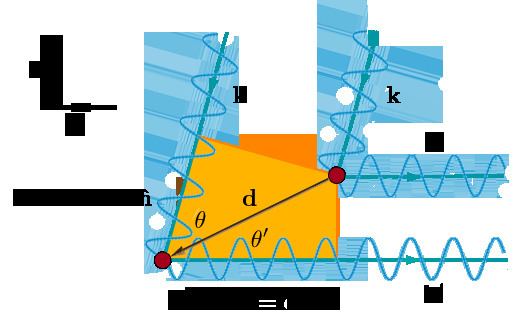In physics, a Bragg plane is a plane in reciprocal space which bisects a reciprocal lattice vector, K , at right angles. The Bragg plane is defined as part of the Von Laue condition for diffraction peaks in x-ray diffraction crystallography.
Considering the diagram on the right, the arriving x-ray plane wave is defined by:
e i k ⋅ r = cos ( k ⋅ r ) + i sin ( k ⋅ r ) Where k is the incident wave vector given by:
k = 2 π λ n ^ where λ is the wavelength of the incident photon. While the Bragg formulation assumes a unique choice of direct lattice planes and specular reflection of the incident X-rays, the Von Laue formula only assumes monochromatic light and that each scattering center acts as a source of secondary wavelets as described by the Huygens principle. Each scattered wave contributes to a new plane wave given by:
k ′ = 2 π λ n ^ ′ The condition for constructive interference in the n ^ ′ direction is that the path difference between the photons is an integer multiple (m) of their wavelength. We know then that for constructive interference we have:
| d | cos θ + | d | cos θ ′ = d ⋅ ( n ^ − n ^ ′ ) = m λ where m ∈ Z . Multiplying the above by 2 π λ we formulate the condition in terms of the wave vectors, k and k ′ :
d ⋅ ( k − k ′ ) = 2 π m Now consider that a crystal is an array of scattering centres, each at a point in the Bravais lattice. We can set one of the scattering centres as the origin of an array. Since the lattice points are displaced by the Bravais lattice vectors, R , scattered waves interfere constructively when the above condition holds simultaneously for all values of R which are Bravais lattice vectors, the condition then becomes:
R ⋅ ( k − k ′ ) = 2 π m An equivalent statement (see mathematical description of the reciprocal lattice) is to say that:
e i ( k − k ′ ) ⋅ R = 1 By comparing this equation with the definition of a reciprocal lattice vector, we see that constructive interference occurs if K = k − k ′ is a vector of the reciprocal lattice. We notice that k and k ′ have the same magnitude, we can restate the Von Laue formulation as requiring that the tip of incident wave vector, k , must lie in the plane that is a perpendicular bisector of the reciprocal lattice vector, K . This reciprocal space plane is the Bragg plane.

